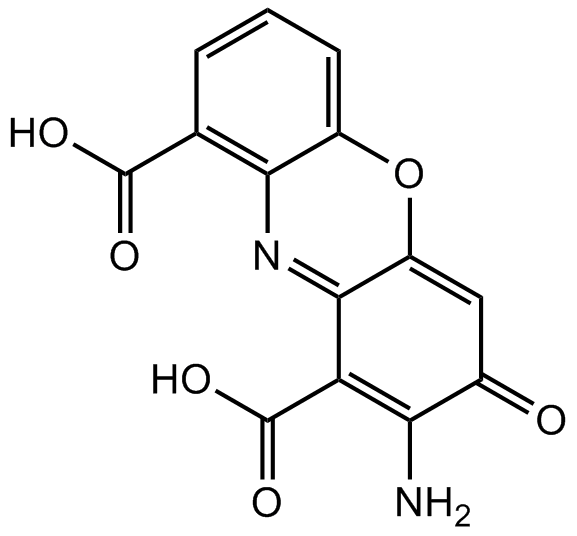Cinnabarinic acid |
| Catalog No.GC12705 |
A mGlu4 receptor agonist
Products are for research use only. Not for human use. We do not sell to patients.

Cas No.: 606-59-7
Sample solution is provided at 25 µL, 10mM.
Cinnabarinic acid is a phenoxazinone produced by the oxidative dimerization of 3-hydroxyanthranilic acid (3-HAA) as part of the metabolism of tryptophan in the kynurenic pathway.[1],[2] It acts as a partial receptor agonist of the metabotropic glutamate receptor 4 (mGlu4), effective at 100 µM, with no activity at other mGlu receptor subtypes.[3] 3-HAA does not affect mGlu receptors, including mGlu4. Cinnabarinic acid induces apoptosis of T cells at 300-500 µM, a potency some ten times that of 3-HAA.[4]
Reference:
[1]. Subba Rao, P.V., and Vaidyanathan, C.S. Enzymic conversion of 3-hydroxyanthranilic acid into cinnabarinic acid. Partial purification and properties of rat-liver cinnabarinate synthase. Biochemistry Journal 99(2), 317-322 (1966).
[2]. Stone, T.W., Stoy, N., and Darlington, L.G. An expanding range of targets for kynurenine metabolites of tryptophan. Trends in Pharamacological Sciences 34(2), 136-143 (2013).
[3]. Fazio, F., Lionetto, L., Molinaro, G., et al. Cinnabarinic acid, an endogenous metabolite of the kynurenine pathway, activates type 4 metabotropic glutamate receptors. Molecular Pharmacology 81(5), 643-656 (2012).
[4]. Hiramatsu, R., Hara, T., Akimoto, H., et al. Cinnabarinic acid generated from 3-hydroxyanthranilic acid strongly induces apoptosis in thymocytes through the generation of reactive oxygen species and the induction of caspase. Journal of Cellular Biochemistry 103(1), 42-53 (2008).
Average Rating: 5 (Based on Reviews and 3 reference(s) in Google Scholar.)
GLPBIO products are for RESEARCH USE ONLY. Please make sure your review or question is research based.
Required fields are marked with *




